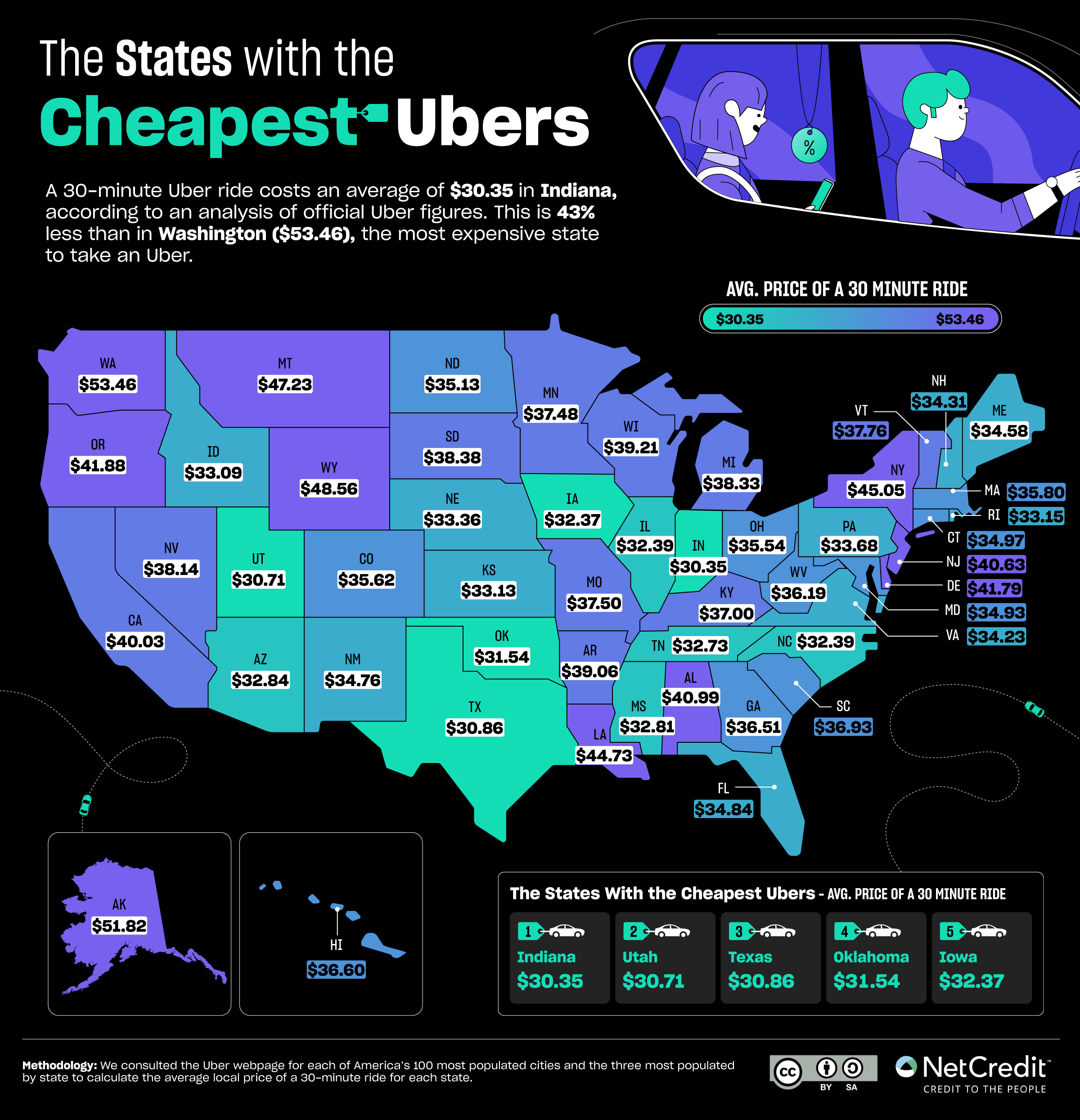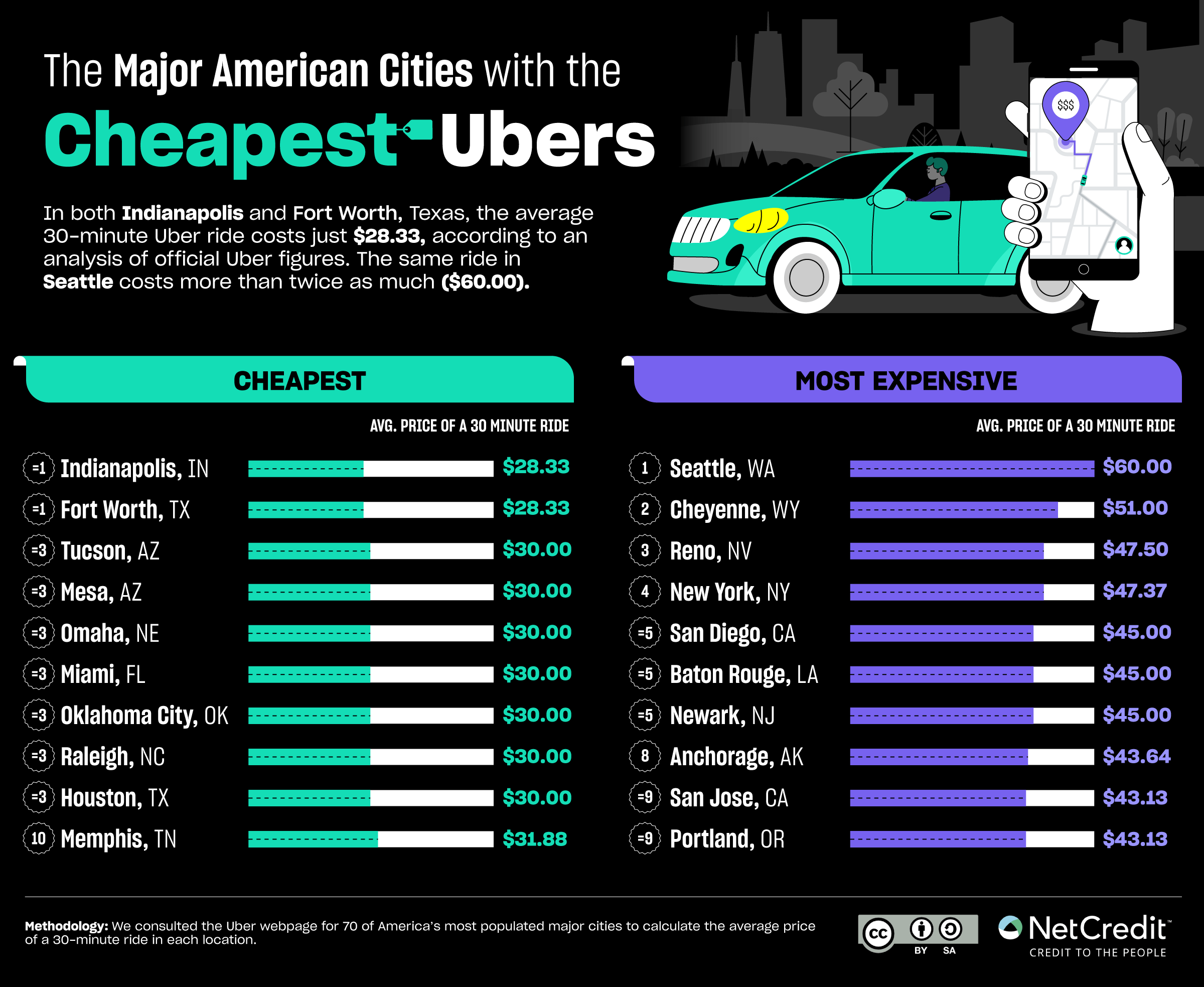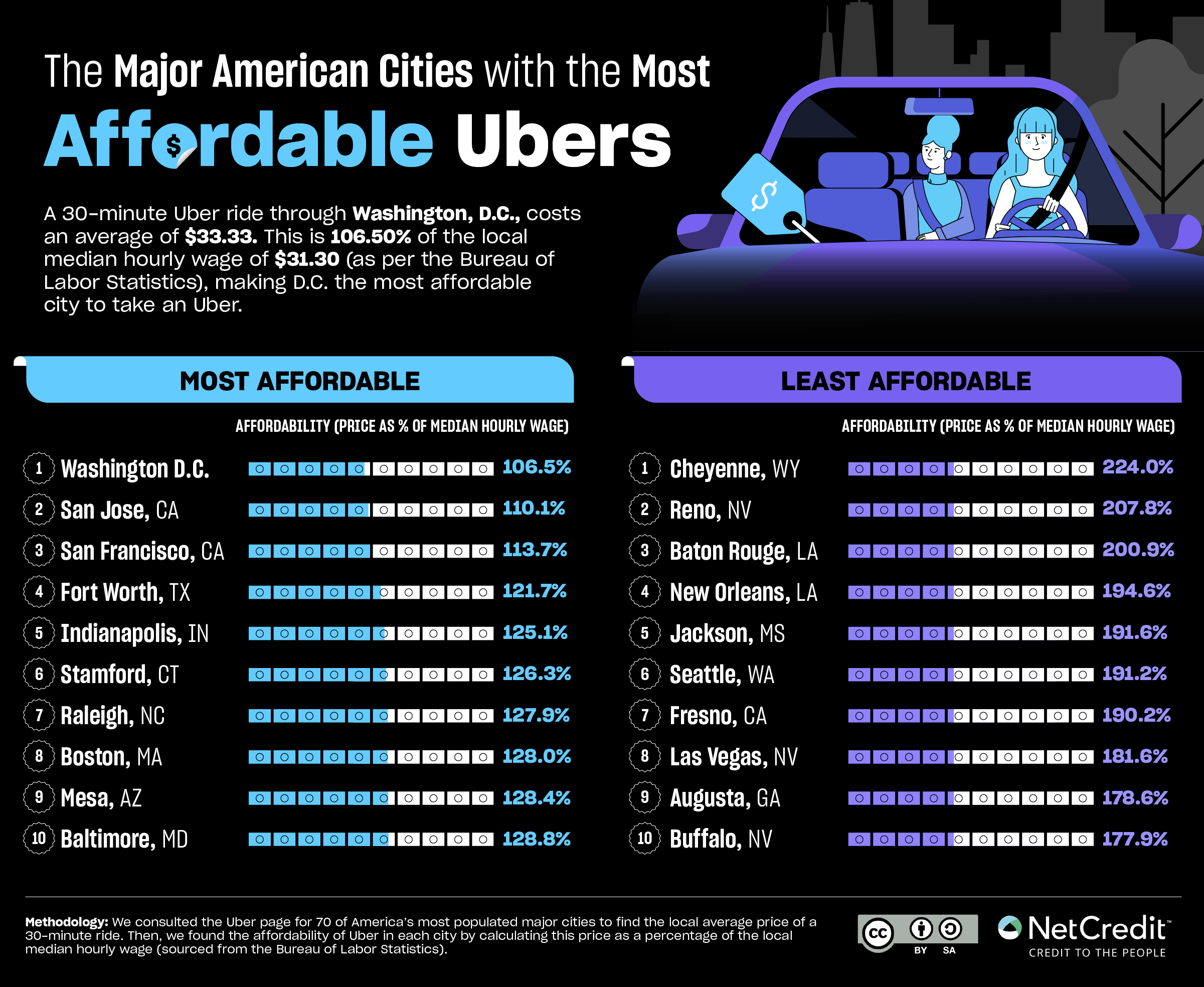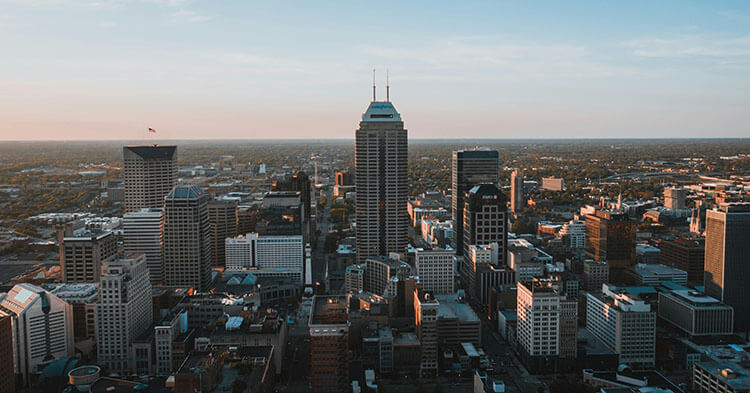The price of Uber rides rose 7.2% across the U.S. in 2024 as both companies grappled with the need to turn a profit while keeping drivers and customers happy. But weekly earnings for Uber drivers fell during this period while they worked longer hours — and customers are looking into cheaper ways to get around town.
It’s not just the price that’s making customers reconsider. Surge pricing makes it difficult to budget, counteracting the ‘convenience’ of app- and network-based services like Uber and Airbnb. “It’s making people miserable to not know what things cost,” Groundwork Collaborative’s Bilal Baydoun told Business Insider. “[W]e live in an age where budgeting is really essential to get by amid a really long-term affordability crisis in this country.”
To build on our analysis of the cost of Uber in cities around the world , we identified the average price for a 30-minute ride in every U.S. state and major city and ranked the cheapest and most expensive. We’ve also compared these costs to the average local hourly wage to see where Uber is most affordable. Read on to explore our data in full.
What we did.
We used the Uber page for each of America’s 100 most populated cities and the three most populated by state to record the average local price estimate. Then, we found the affordability of Uber in each city and state by calculating the local average price of a 30-minute ride in each city and state as a percentage of the local average hourly wage (sourced from the Bureau of Labor Database).
Key Findings: How much does a 30-minute uber cost?
- Indiana is the state with the cheapest average 30-minute Uber ride ($30.35).
- Fort Worth, Texas, and Indianapolis are the cities with the joint cheapest Uber rides ($28.33 for 30 minutes).
- The most expensive average Uber ride is in Seattle, where 30 minutes costs an average of $60.00.
- The city with the most affordable Uber rides is Washington, D.C., where a 30-minute trip costs 106.5% of the average hourly wage.
An Uber in Utah costs 43% less than Washington.
 The average Uber ride in Washington ($53.46) costs 1.76 times as much as in Indiana ($30.35). Earlier this year, Washington legislators attempted to limit surge pricing, particularly ahead of the 2026 World Cup.
The average Uber ride in Washington ($53.46) costs 1.76 times as much as in Indiana ($30.35). Earlier this year, Washington legislators attempted to limit surge pricing, particularly ahead of the 2026 World Cup.
One driver testified that he’d had to charge over $200 for a ride home from a Taylor Swift concert, and “[n]ot even half of the charge was to pay me as their driver.” However, the lawmakers withdrew the proposal before it reached the Senate, although they may revisit the issue.
Indiana has the cheapest average Uber ride of any state. Despite this, Indiana’s Uber drivers enjoy the third-best salary compared to the local cost of living, according to one study.
Indianapolis is the cheapest city to take an Uber.
 Next, we looked at the average price of a ride in America’s 100 biggest cities. Of these, Seattle is the most expensive at $60.00 for a 30-minute trip (see Washington above). Indianapolis and Fort Worth, Texas, have the joint cheapest trip at $28.33.
Next, we looked at the average price of a ride in America’s 100 biggest cities. Of these, Seattle is the most expensive at $60.00 for a 30-minute trip (see Washington above). Indianapolis and Fort Worth, Texas, have the joint cheapest trip at $28.33.
Uber recently saw new competition in Indianapolis through inDrive, a rideshare app where the customer proposes a price, and it’s up to the driver to accept it or counter-bid. The customer also has more power of choice over the nature of the ride.
“We’re giving both the driver and passenger the freedom to kind of choose their own adventure,” said Adam Warner, head of U.S. operations. “So you get to select the driver. Are you willing to wait 10 minutes for this person to pick you up in a Tesla Model Y, or are you comfortable with the Chevy Malibu that’s only two minutes away to pick you up?”
Washington, D.C., has the most affordable rides compared to local wages.
 Next, we found the average cost of a 30-minute ride in each of America’s biggest cities as a percentage of the local average hourly wage. We found that Washington, D.C. (106.5%) gets the best deal, with a half-hour ride ($33.33) costing a little over an hour’s pay ($31.30).
Next, we found the average cost of a 30-minute ride in each of America’s biggest cities as a percentage of the local average hourly wage. We found that Washington, D.C. (106.5%) gets the best deal, with a half-hour ride ($33.33) costing a little over an hour’s pay ($31.30).
Like Indianapolis (above), D.C. has seen a rival to Uber spring up. However, the service — called Empower — is “not registered with DFHV and is not authorized to operate as a ride share provider in the District,” according to the city’s Department of For-Hire Vehicles. In turn, Empower’s CEO argues that the company is not beholden to the DFHV as the company doesn’t take a cut from each fare. Instead, drivers pay a monthly subscription for access to the network.
How to save money using Uber.
There is no denying the convenience of Uber, which has helped make it a success story despite the misgivings and controversies the brand has encountered along the way. But that convenience comes at a price. Thankfully, there are ways to keep your fare down — try these tips to get a cheaper ride.
- Try closing the app, waiting for two minutes, and reopening it. Travel blogger Wandering Earl claims that this may reset automatic price surging, which could be tied to predefined periods rather than reacting to actual surges in demand.
- Consider using UberX Share (formerly UberPool), a ride-pooling option within the app itself — although it does mean sharing your ride with strangers.
- If traveling with friends, set the Uber app to split your fare automatically so you don’t forget to exchange cash after the trip.
- If you can make your trip at a different time, avoid weekend evenings and peak weekday commuting hours to get around price surging.
- It can be more economical to use a combination of Uber and public transport than to own and run your own car, particularly if you live in the heart of the city. A few extra rideshare trips each month can easily be offset by selling your own vehicle.
The cost of disruption.
Rideshare apps are a true disruptor technology, changing how we get around and offering unprecedented convenience. But they have also disrupted the knowability fares, causing knock-on implications for household budgets. And with prices on the rise, it has become necessary to balance this convenience against the cost and other ethical factors of taking an Uber. You can see our full data and sort by city/state or price/affordability using the table below to help make your choice.
Methodology
First, we created a seedlist of cities that included the 100 most populated across America and the three most populated by state.
Consulting the Uber page for each city on the official website, we recorded the average price estimates for each one. Where these price estimates were for 15-minute rides, we scaled up the figures to calculate the average price of a 30-minute ride.
To determine the affordability of 30-minute rides in every state and city, we calculated the price as a percentage of the median local hourly wage (sourced from the Bureau of Labor Statistics) from their corresponding metropolitan area.
Data is correct as of March 2025.
DISCLAIMER: This content is for informational purposes only and should not be considered financial, investment, tax or legal advice.






